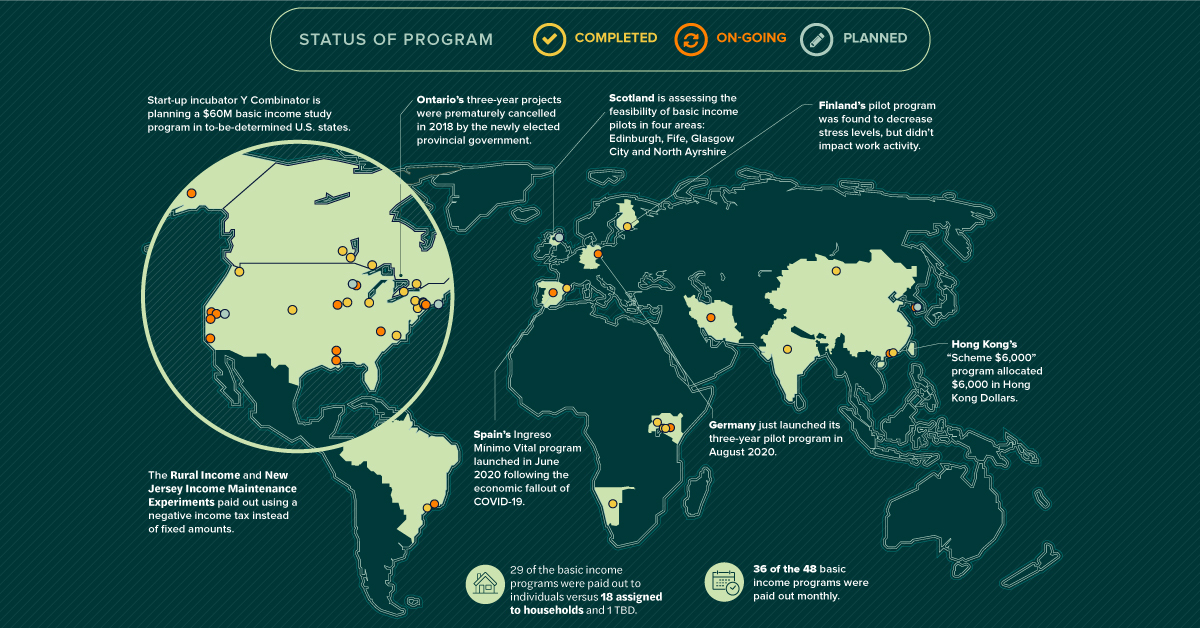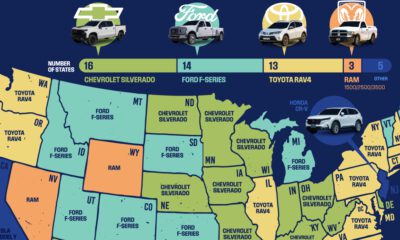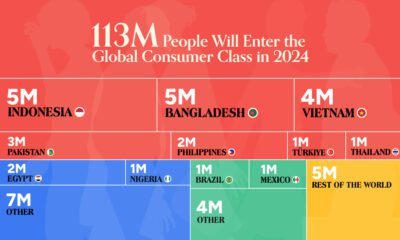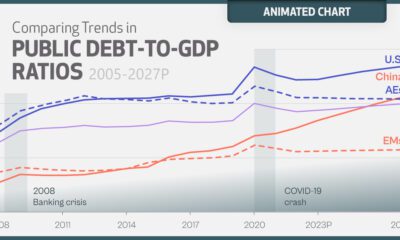Politics
Basic Income Experiments Around the World

Basic Income Experiments Around the World
What if everyone received monthly payments to make life easier and encourage greater economic activity? That’s the exact premise behind Universal Basic Income (UBI).
The idea of UBI as a means to both combat poverty and improve economic prospects has been around for decades. With the COVID-19 pandemic wreaking havoc on economies worldwide, momentum behind the idea has seen a resurgence among certain groups.
Of course, the money to fund basic income programs has to come from somewhere. UBI relies heavily on government budgets or direct funding to cover the regular payments.
As policymakers examine this trade-off between government spending and the potential benefits, there is a growing pool of data to draw inferences from. In fact, basic income has been piloted and experimented on all around the world—but with a mixed bag of results.
What Makes Basic Income Universal?
UBI operates by giving people the means to meet basic necessities with a regular stipend. In theory, this leaves them free to spend their money and resources on economic goods, or searching for better employment options.
Before examining the programs, it’s important to make a distinction between basic income and universal basic income.

With these parameters in mind, and thanks to data from the Stanford Basic Income Lab, we’ve mapped 48 basic income programs that demonstrate multiple features of UBI and are regularly cited in basic income policy.
Some mapped programs are past experiments used to evaluate basic income. Others are ongoing or new pilots, including recently launched programs in Germany and Spain.
Recently, Canada joined the list as countries considering UBI as a top policy priority in a post-COVID world. But as past experiments show, ideas around basic income can be implemented in many different ways.
Basic Income Programs Took Many Forms
Basic income pilots have seen many iterations across the globe. Many paid out in U.S. dollars, while others chose to stick with local currencies (marked by an asterisk for estimated USD value).
| Program | Location | Recipients | Payment Frequency | Amount ($US/yr) | Dates |
|---|---|---|---|---|---|
| Abundant Birth Project | San Francisco, U.S. | 100 | Monthly | $12,000-$18,000 | TBD |
| Alaska Permanent Fund Dividend | Alaska, U.S. | 667,047 | Annually | $1,000-$2,000 | 1982-Present |
| B-MINCOME | Barcelona, Spain | 1,000 | Monthly | $1,392-$23,324* | 2017-2019 |
| Baby's First Years | New York, U.S. | 1,000 | Monthly | $240-$3,996 | 2017-2022 |
| Baby's First Years | New Orleans, U.S. | 1,000 | Monthly | $240-$3,996 | 2017-2022 |
| Baby's First Years | Omaha, U.S. | 1,000 | Monthly | $240-$3,996 | 2017-2022 |
| Baby's First Years | Twin Cities, U.S. | 1,000 | Monthly | $240-$3,996 | 2017-2022 |
| Basic Income for Farmers | Gyeonggi Province, South Korea | 430,000 | Annually | $509* | TBD |
| Basic Income Grant (BIG) Pilot | Omitara, Namibia | 930 | Monthly | $163* | 2008-2009 |
| Basic Income Project | Not Disclosed | 3,000 | Monthly | $600-$12,000 | 2019-Present |
| Eastern Band of Cherokee Indians Casino Revenue Fund | Jackson County and area, NC, U.S. | 15,414 | Biannually | $7,000-$12,000 | 1996-Present |
| Eight Pilot Project | Busibi, Uganda | 150 | Monthly | $110-$219* | 2017-2019 |
| Evaluation of the Citizens' Basic Income Program | Maricá, Brazil | 42,000 | Monthly | $360* | 2019-Present |
| Finland Basic Income Experiment | Finland | 2,000 | Monthly | $7,793* | 2017-2018 |
| Gary Income Maintenance Experiments | Gary, U.S. | 1,782 | Monthly | $3,300-$4,300 | 1971-1974 |
| Give Directly | Western Kenya | 20,847 | Monthly or Lump Sum | $274 | 2017-2030 |
| Give Directly | Saiya County, Kenya | 10,500 | Lump Sum | $333 | 2014-2017 |
| Give Directly | Rarieda District, Kenya | 503 | Monthly or Lump Sum | $405-$1,525 | 2011-2013 |
| Human Development Fund | Mongolia | 2,700,000 | Monthly | $187 | 2010-2012 |
| Ingreso Mínimo Vital | Spain | 850,000 | Monthly | $6,535-$14,358* | 2020-Present |
| Iran Cash Transfer Programme | Iran | 75,000,000 | Monthly | $48 | 2010-Present |
| Madhya Pradesh Unconditional Cash Transfers Project | Madhya Pradesh, India | 5,547 | Monthly | $26-$77* | 2011-2012 |
| Magnolia Mother's Trust | Jackson, MS, U.S. | 80 | Monthly | $12,000 | 2019-Present |
| Manitoba Basic Annual Income Experiment | Winnipeg, Canada | 1,677 | Monthly | $3,842-$5,864* | 1975-1978 |
| Manitoba Basic Annual Income Experiment | Dauphin, Canada | 586 | Monthly | $3,842-$5,864* | 1975-1978 |
| My Basic Income | Germany | 120 | Monthly | $17,160* | 2020-2023 |
| New Jersey Income Maintenance Experiment | Jersey City, U.S. | 1,357 | Biweekly | Varied | 1968-1972 |
| New Jersey Income Maintenance Experiment | Paterson, NJ, U.S. | 1,357 | Biweekly | Varied | 1968-1972 |
| New Jersey Income Maintenance Experiment | Passaic, NJ, U.S. | 1,357 | Biweekly | Varied | 1968-1972 |
| New Jersey Income Maintenance Experiment | Trenton, NJ, U.S. | 1,357 | Biweekly | Varied | 1968-1972 |
| New Jersey Income Maintenance Experiment | Scranton, PA, U.S. | 1,357 | Biweekly | Varied | 1968-1972 |
| Ontario Basic Income Pilot | Hamilton and area, Canada | 2,748 | Monthly | $13,112-$18,930* (-50% income) | 2017-2018 |
| Ontario Basic Income Pilot | Thunder Bay and area, Canada | 1,908 | Monthly | $13,112-$18,930* (-50% income) | 2017-2018 |
| Ontario Basic Income Pilot | Lindsay, Canada | 1,844 | Monthly | $13,112-$18,930* (-50% income) | 2017-2018 |
| Preserving Our Diversity | Santa Monica, U.S. | 250 | Monthly | $7,836-$8,964 | 2017-Present |
| Quatinga Velho | Quatinga, Mogi das Cruces, Brazil | 67 | Monthly | $197* | 2008-2014 |
| Rural Income Maintenance Experiment | Duplin County, NC, U.S. | 810 | Monthly | Varied (NIT) | 1970-1972 |
| Rural Income Maintenance Experiment | Iowa, U.S. | 810 | Monthly | Varied (NIT) | 1970-1972 |
| Scheme $6,000 | Hong Kong, China | 4,000,000 | Annually | $771* | 2011-2012 |
| Seattle-Denver Income Maintenance Experiment | Seattle, U.S. | 2,042 | Monthly | $3,800-$5,600 | 1971-1982 |
| Seattle-Denver Income Maintenance Experiment | Denver, U.S. | 2,758 | Monthly | $3,800-$5,600 | 1971-1982 |
| Stockton Economic Empowerment Demonstration | Stockton, U.S. | 125 | Monthly | $6,000 | 2019-Present |
| TBD | Newark, U.S. | TBD | Monthly | TBD | TBD |
| Transition-Age Youth Basic Income Pilot Program | Santa Clara, CA, U.S. | 72 | Monthly | $12,000 | 2020-2021 |
| Wealth Partaking Scheme | Macau, China | 700,600 | Annually | $750-$1,150 | 2008-Present |
| Youth Basic Income Program | Gyeonggi Province, South Korea | 125,000 | Quarterly | $848* | 2018-Present |
| Citizen's Basic Income Pilot | Scotland | TBD | Monthly | TBD | TBD |
| People's Prosperity Guaranteed Income Demonstration Pilot | St. Paul, U.S. | 150 | Monthly | $6,000 | 2020-2022 |
Many of the programs meet the classical requirements of UBI. Of the 48 basic income programs tallied above, 75% paid out monthly, and 60% were paid out to individuals.
However, for various reasons, not all of these programs follow UBI requirements. For example, 38% of the basic income programs were paid out to households instead of individuals, and many programs have paid out in lump sums or over varying time frames.
Interestingly, the need for better understanding of basic income has resulted in many divergences between programs. Some programs were only targeted at specific groups like South Korea’s Basic Income for Farmers program, while others like the Baby’s First Years program in the U.S. have been experimenting with different dollar amounts in order to evaluate efficiency.
Other experiments based payments made off of the total income of recipients. For example, in the U.S., the Rural Income and New Jersey Income Maintenance Experiments paid out using a negative income tax (return) on earnings, while recipients of Canada’s Ontario Basic Income Pilot received fixed amounts minus 50% of their earned income.
Varying Programs with Varied Results
So is basic income the real deal or a pipe dream? The results are still unclear.
Some, like the initial pilots for Uganda’s Eight program, were found to result in significant multipliers on economic activity and well-being. Other programs, however, returned mixed results that made further experimentation difficult. Finland’s highly-touted pilot program decreased stress levels of recipients across the board, but didn’t positively impact work activity.
The biggest difficulty has been in keeping programs going and securing funding. Ontario’s three-year projects were prematurely cancelled in 2018 before they could be completed and assessed, and the next stages of Finland’s program are in limbo.
Likewise in the U.S., start-up incubator Y Combinator has been planning a $60M basic income study program, but can’t proceed until funding is secured.
A Post-COVID Future for UBI?
In light of COVID-19, basic income has once again taken center stage.
Many countries have already implemented payment schemes or boosted unemployment benefits in reaction to the pandemic. Others like Spain have used that momentum to launch fully-fledged basic income pilots.
It’s still too early to tell if UBI will live up to expectations or if the idea will fizzle out, but as new experiments and policy programs take shape, a growing amount of data will become available for policymakers to evaluate.
Economy
The Bloc Effect: International Trade with Geopolitical Allies on the Rise
Rising geopolitical tensions are shaping the future of international trade, but what is the effect on trading among G7 and BRICS countries?

The Bloc Effect: International Trade with Allies on the Rise
International trade has become increasingly fragmented over the last five years as countries have shifted to trading more with their geopolitical allies.
This graphic from The Hinrich Foundation, the first in a three-part series covering the future of trade, provides visual context to the growing divide in trade in G7 and pre-expansion BRICS countries, which are used as proxies for geopolitical blocs.
Trade Shifts in G7 and BRICS Countries
This analysis uses IMF data to examine differences in shares of exports within and between trading blocs from 2018 to 2023. For example, we looked at the percentage of China’s exports with other BRICS members as well as with G7 members to see how these proportions shifted in percentage points (pp) over time.
Countries traded nearly $270 billion more with allies in 2023 compared to 2018. This shift came at the expense of trade with rival blocs, which saw a decline of $314 billion.
Country Change in Exports Within Bloc (pp) Change in Exports With Other Bloc (pp)
🇮🇳 India 0.0 3.9
🇷🇺 Russia 0.7 -3.8
🇮🇹 Italy 0.8 -0.7
🇨🇦 Canada 0.9 -0.7
🇫🇷 France 1.0 -1.1
🇪🇺 EU 1.1 -1.5
🇩🇪 Germany 1.4 -2.1
🇿🇦 South Africa 1.5 1.5
🇺🇸 U.S. 1.6 -0.4
🇯🇵 Japan 2.0 -1.7
🇨🇳 China 2.1 -5.2
🇧🇷 Brazil 3.7 -3.3
🇬🇧 UK 10.2 0.5
All shifts reported are in percentage points. For example, the EU saw its share of exports to G7 countries rise from 74.3% in 2018 to 75.4% in 2023, which equates to a 1.1 percentage point increase.
The UK saw the largest uptick in trading with other countries within the G7 (+10.2 percentage points), namely the EU, as the post-Brexit trade slump to the region recovered.
Meanwhile, the U.S.-China trade dispute caused China’s share of exports to the G7 to fall by 5.2 percentage points from 2018 to 2023, the largest decline in our sample set. In fact, partly as a result of the conflict, the U.S. has by far the highest number of harmful tariffs in place.
The Russia-Ukraine War and ensuing sanctions by the West contributed to Russia’s share of exports to the G7 falling by 3.8 percentage points over the same timeframe.
India, South Africa, and the UK bucked the trend and continued to witness advances in exports with the opposing bloc.
Average Trade Shifts of G7 and BRICS Blocs
Though results varied significantly on a country-by-country basis, the broader trend towards favoring geopolitical allies in international trade is clear.
Bloc Change in Exports Within Bloc (pp) Change in Exports With Other Bloc (pp)
Average 2.1 -1.1
BRICS 1.6 -1.4
G7 incl. EU 2.4 -1.0
Overall, BRICS countries saw a larger shift away from exports with the other bloc, while for G7 countries the shift within their own bloc was more pronounced. This implies that though BRICS countries are trading less with the G7, they are relying more on trade partners outside their bloc to make up for the lost G7 share.
A Global Shift in International Trade and Geopolitical Proximity
The movement towards strengthening trade relations based on geopolitical proximity is a global trend.
The United Nations categorizes countries along a scale of geopolitical proximity based on UN voting records.
According to the organization’s analysis, international trade between geopolitically close countries rose from the first quarter of 2022 (when Russia first invaded Ukraine) to the third quarter of 2023 by over 6%. Conversely, trade with geopolitically distant countries declined.
The second piece in this series will explore China’s gradual move away from using the U.S. dollar in trade settlements.

Visit the Hinrich Foundation to learn more about the future of geopolitical trade

-

 Economy6 hours ago
Economy6 hours agoEconomic Growth Forecasts for G7 and BRICS Countries in 2024
The IMF has released its economic growth forecasts for 2024. How do the G7 and BRICS countries compare?
-

 United States1 week ago
United States1 week agoRanked: The Largest U.S. Corporations by Number of Employees
We visualized the top U.S. companies by employees, revealing the massive scale of retailers like Walmart, Target, and Home Depot.
-

 Economy2 weeks ago
Economy2 weeks agoWhere U.S. Inflation Hit the Hardest in March 2024
We visualized product categories that saw the highest % increase in price due to U.S. inflation as of March 2024.
-

 Economy4 weeks ago
Economy4 weeks agoG20 Inflation Rates: Feb 2024 vs COVID Peak
We visualize inflation rates across G20 countries as of Feb 2024, in the context of their COVID-19 pandemic peak.
-

 Economy1 month ago
Economy1 month agoMapped: Unemployment Claims by State
This visual heatmap of unemployment claims by state highlights New York, California, and Alaska leading the country by a wide margin.
-

 Economy2 months ago
Economy2 months agoConfidence in the Global Economy, by Country
Will the global economy be stronger in 2024 than in 2023?
-

 Markets1 week ago
Markets1 week agoU.S. Debt Interest Payments Reach $1 Trillion
-

 Markets2 weeks ago
Markets2 weeks agoRanked: The Most Valuable Housing Markets in America
-

 Money2 weeks ago
Money2 weeks agoWhich States Have the Highest Minimum Wage in America?
-

 AI2 weeks ago
AI2 weeks agoRanked: Semiconductor Companies by Industry Revenue Share
-

 Markets2 weeks ago
Markets2 weeks agoRanked: The World’s Top Flight Routes, by Revenue
-

 Countries2 weeks ago
Countries2 weeks agoPopulation Projections: The World’s 6 Largest Countries in 2075
-

 Markets2 weeks ago
Markets2 weeks agoThe Top 10 States by Real GDP Growth in 2023
-

 Money2 weeks ago
Money2 weeks agoThe Smallest Gender Wage Gaps in OECD Countries



















